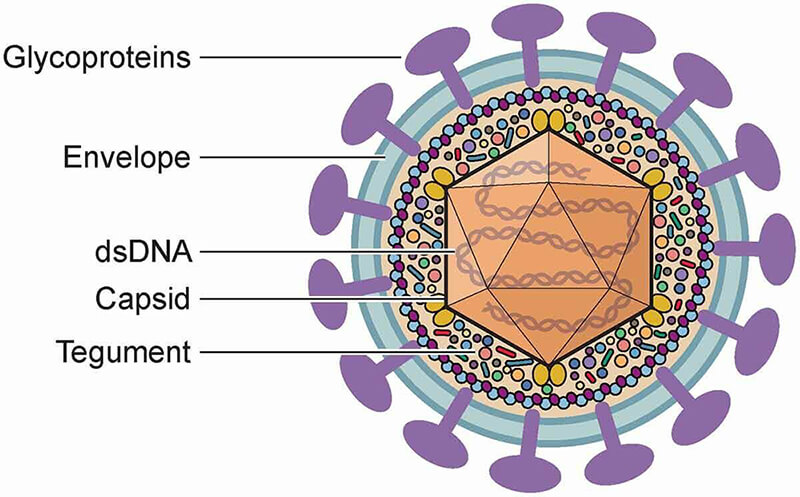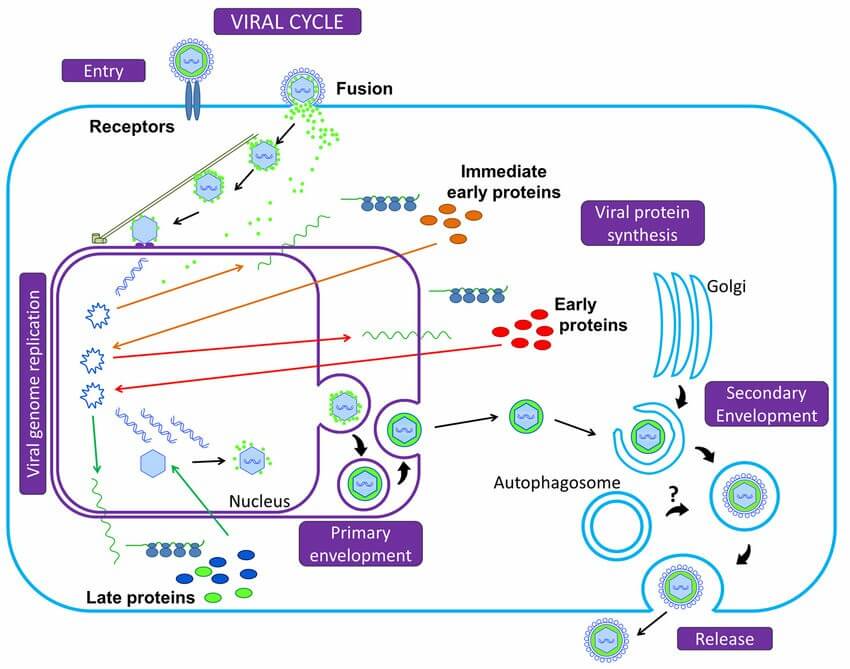Herpes Simplex Virus Antigens
Herpes simplex virus, abbreviated as HSV, is a member of the Herpesvirus family, and a species that infects humans only. HSV has two major serotypes: HSV-1 and HSV-2. HSV-1 is mainly transmitted by oral-to-oral contact, causing oral herpes (including symptoms known as cold sores), but it can also lead to genital herpes. HSV-2 is a sexually transmitted infection that causes genital herpes. Most HSV infections are asymptomatic, but symptoms of herpes include painful blisters or ulcers that can recur over time. There is no cure for herpes simplex. Once a person has the virus, it remains in the body. The virus lies inactive in the nerve cells until something triggers it to become active again. HSV-1 and HSV-2 are transmitted by contact with an infected person who has reactivations of the virus. About 67% of the world population under the age of 50 has HSV-1. In the United States, about 47.8% and 11.9% are believed to have HSV-1 and HSV-2, respectively. Because it can be transmitted through any intimate contact, it is one of the most common sexually transmitted infections.
HSV are composed of a large, double-stranded DNA core, an icosohedral capsid, an amorphous protein tegument, and an outer lipid bilayer envelope. The viral has a 152 kbp dsDNA encoding probably 84 proteins. The genomes of HSV are complex and contain two unique regions called the long unique region (UL) and the short unique region (US) that is flanked by inverted repeats. The tegument layer is an amorphous collection of at least 20 proteins which have important roles in subverting the host antiviral response early after infection. The lipid envelope that surrounds the virus contains 11 viral encoded glycoproteins and is responsible for attachment and penetration into the host cell, as well as inciting the host inflammatory response. Two of these glycoproteins (gB or gD, or both) have been used in subunit vaccines research.

Fig.1 The Herpes simplex virus virion1
HSV attaches to the host cell via three different receptors (gB, gC, gD). The main targets of gB and gC are heparan-sulfate proteoglycans (HSPGs), and gB has also been reported to bind to the paired immunoglobulin-like type 2 receptor (PILR) on the cell surface. The envelope fuses with the plasma membrane, releasing the capsid into the cytoplasm. Once it reaches the nuclear pore, the capsid releases the viral DNA into the nucleus. Viral genome transcription, viral DNA replication, and assembly of new capsids take place in the nucleus. Transcription of viral proteins follows a temporal course of immediate early (alpha), early (beta), and late (gamma) gene products. To commence transcription, the host RNA polymerase II transcribes the viral DNA into alpha mRNA. The alpha gene products are responsible for regulation of viral replication, as well as ensuring transcription of beta proteins. Beta proteins are involved in DNA synthesis and packaging. Following viral DNA synthesis, structural components and assembly of the capsid, tegument, and envelope are encoded by the gamma proteins. Viral proteins aid in packaging the DNA into preformed capsids.

Fig.2 Herpesvirus replication cycle2
Creative Diagnostics is a leading manufacturer of high-quality herpes simplex virus antigens. We carry HSV type 1, type 2, HSV type 1 Glycoprotein, HSV type 1 Glycoprotein G, HSV type 2 Glycoprotein D, HSV type 2 Glycoprotein G and HSV type 8 Mosaic protein. Please feel free to contact our sales representative if you have any questions.
References
- Zhu S, Viejo-Borbolla A. (2021). Pathogenesis and virulence of herpes simplex virus. Virulence. 12(1):2670-2702.
- Lussignol M, Esclatine A. (2017). Herpesvirus and Autophagy: “All Right, Everybody Be Cool, This Is a Robbery!”. Viruses, 9(12):372.





Leave Your Comment